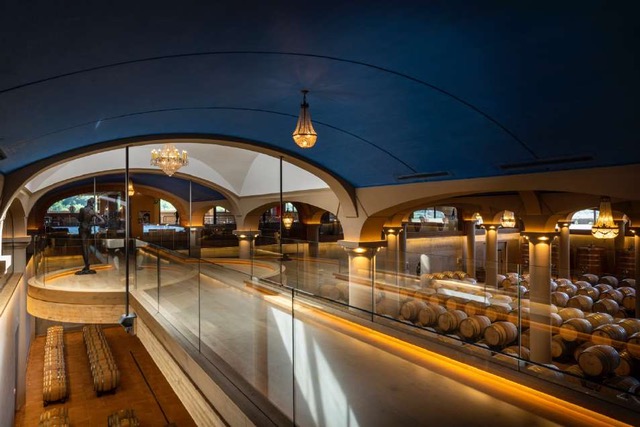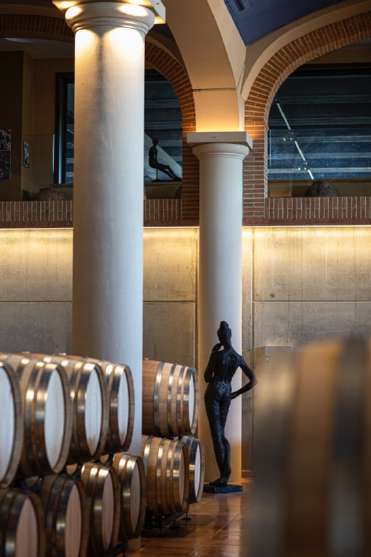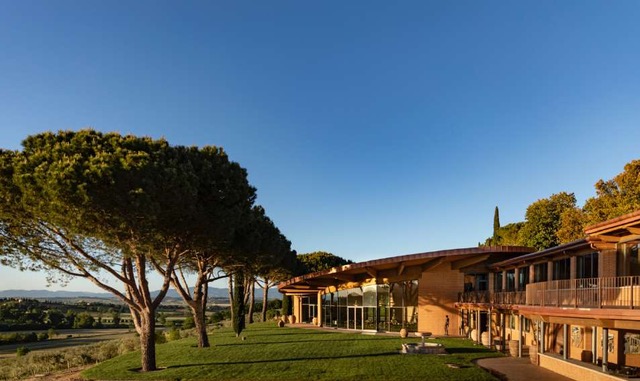The art of Vino Nobile di Montepulciano: 40 years of Tenuta Vallocaia
On the occasion of Tuscan producer Tenuta Vallocaia’s 40th anniversary, Filippo Bartolotta spoke with founder Rudi Bindella Sr. about what drew him to Montepulciano, why art takes centre stage at his new winery, and what 2024 holds for the fine wine market.

Opening with The Beatles’ All You Need is Love, Tenuta Vallocaia founder and passionate musician Rudi Bindella Sr. and his band marked the 40th anniversary of one of the most dynamic companies in Montepulciano. The occasion also marked the handover from Rudi Bindella Sr. to his son, also called Rudi.
Bindella Sr, the heir to an Italian-Swiss family of wine merchant which had been importing Italian wines into Switzerland since the 1960s and today has a €200 million turnover, fell in love with Tuscany, following his father on trips to the great Tuscan producers – primarily the Antinori family, who would become the main partner in Switzerland – and discovering the beauty of those territories.
Later, in 1983, while the local wine culture was in a primordial phase, Bindella Sr. purchased a small, semi-ruined property in the historical heart of Montepulciano’s wine production: Vallocaia, in the Argiano area. At the time it had two and a half hectares of vineyards, and Bindella Sr., a ‘humanistic’ entrepreneur who is passionate about art, culture and beauty, as well as great wines, saw it as an opportunity to show the value of this territory while maintaining a balance between earth, men and business in every step of the production.
Under the careful guidance of technical director Giovanni Capuano, the property gradually expanded with the purchase of some important plots as well as olive groves and woods adjacent to the vineyards, which diversified production and increased biodiversity. Four decades later, the Vallocaia estate extends over 175ha, 65ha of which are under vine and another 16ha dedicated to olive groves.
In its 40 years of life, nestled on a hill looking over the Val di Chiana, Tenuta Vallocaia has seen the transformation of this prized wine-growing area. Vallocaia is the Nobile of today, being one of the key companies to support and guide the evolution of the Nobile di Montepulciano DOCG until the birth of today’s zoning system, Le Pievi.
Tasting the Vallocaia Nobile 2022, which seemed more restrained and austere at the beginning of the year, it is now showing the depth and character of a great Nobile.

Capuano said: “From the 2021 vintage we can use Le Pievi subzones on the label, but the wines will be released on the market from 2025. Le Pievi is a project dedicated to the renaissance of Vino Nobile to highlight the rich expressions of Sangiovese in the different growing zones or terroirs of Montepulciano.”
Bindella Sr. added: “We have been working on the goals of the project since our arrival, because we have great respect for the traditional wine-growing culture of Montepulciano.”
Partner Content
Other flagship DOCG wines in the production include the Vallocaia Nobile di Montepulciano DOCG Riserva, Bindella Nobile di Montepulcinao DOCG, and, one of the best Nobiles I tasted at this year’s en primeur, I Quadri Nobile di Montepulciano DOCG, a leathery and slightly smoky Sangiovese with Mediterranean herbs, graphite, raspberry, and an elegant earthiness, making for an intense and velvety Nobile with some serious ageing potential.
The winery of Tenuta Vallocaia is a modern building, but with an ancient heart: red brick, barrels and barriques in sight, and large windows permitting views of the picturesque landscape of Montepulciano, dotted with pines and cypress trees.
Bindella Sr. wanted conviviality to be at the centre of the estate, so he created spaces where one can fully enjoy the beauty and flavours of simple, authentic, seasonal Tuscan dishes, enhanced by ingredients from the estate’s gardens. Every aspect of the winery shows the love and joy that wine has brought to this entrepreneur, and the love and joy he wants to share with others. Tenuta di Vallocaia isn’t just a winery, it is also home to a beautiful art collection which seems to have been curated with the wine firmly in mind.
“Art is a natural part of all our ventures,” Bindella Sr. claimed. “I like art, just like I like Italy. The art in our wineries is there not as a show, but to be one with the winery. It shapes the environment and affects employees and guests. Our wines, Tuscan wines, should reflect the beauty of the landscape and the spaces in which they grow up…I have been in love with Tuscany since the 70s, when I was a student in Perugia, so when we were looking for a winery, Montepulciano was the first choice. We have never regretted this decision.”
“Montepulciano has a unique geological, pedological landscape and cultural characteristics that give Nobile a distinctive identity,” Capuano added. “Even though its neighbours enjoy greater fame, Nobile is regaining its historical reputation, showing what different soils and microclimates give the Sangiovese in terms of aroma, acidity, polyphenols and concentration – and Le Pievi sub-zones are there to prove this.”

When asked about if he had any favourites from his wine collection, Bindella Sr. said he liked red wines from Bordeaux and Burgundy and increasingly, Italian wines.
“Italy has started to build fine wines from the ’70s with producers like Piero Antinori and Marchese Incisa della Rocchetta. I still love the fine reds of France but I like the wines of Tuscany more and more, as Cotarella [Antinori CEO] says: ‘People love Tuscan wines because they reflect the beauty of the sweet and round hilly landscape of the region’.”
As for the market outlook for 2024, Bindella Sr. said: “There’s a strong trend towards organic wines, and people are drinking less wines, and usually lower alcohol and less expensive ones. We will need some time to adjust towards these changes, but those that work towards quality won’t lose any market share. In Switzerland, the market for classic fine wines is still very strong – we actually do not have enough bottles to satisfy demand for these types of wines. The clients for this range are usually 40-years-old or older, but I am sure that the younger generation will come round to love these classics.”
Related news
Castel Group leadership coup escalates
For the twelfth day of Christmas...
Zuccardi Valle de Uco: textured, unique and revolutionary wines




